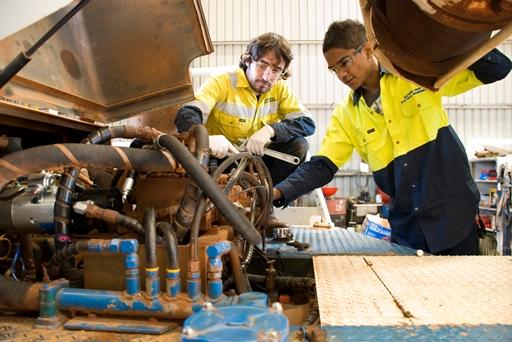Apprenticeships and traineeships are an excellent way to combine training with work, enabling you to have a job while you complete training towards a nationally recognised qualification. They are available to anyone of working age.
You can do an apprenticeship or traineeship if you are a school-leaver, re-entering the workforce or as an adult or mature-aged person wishing to change careers. You can even begin your apprenticeship or traineeship while you're still at school.
When you finish your apprenticeship or traineeship you will have a nationally recognised qualification that's held in high regard in many overseas countries as well.
What is the difference between an apprenticeship and a traineeship?

Apprenticeships typically take three or four years to complete and traditionally cover skilled trade areas such as engineering and metal fabrication, automotive and mechanical, construction and building and electrical specialisations; as well as hairdressing, landscaping, hospitality and cookery.
An apprenticeship is a structured program with a combination of on the job and off the job training, where you gain hands-on skills and knowledge.
Upon successful completion, apprentices become a qualified tradesperson.
Traineeships can take between one to two years to complete and offer a broader range of vocational and occupational choices – anything from multimedia and information technology, through to sport and fitness, agriculture, music, aged care, civil engineering and business.
A traineeship provides hands-on skills and work experience, and can improve your employment prospects and range of career choices.
Upon successful completion, a trainee will receive a nationally recognised qualification in their chosen vocational area.
Mature-aged (adult) apprenticeships
Apprenticeships are not just for young people! A mature-aged or adult apprenticeship is a great option for career changers or people who are re-entering the workforce, and age is no restriction – anyone can do an apprenticeship, and many employers prefer to take on a mature-aged apprentice as they often have skills and experience that younger apprentices p do not have. As long as you are eager, willing to learn and driven, you can be successful.
Mature-aged apprenticeships work exactly the same as any other apprenticeship – you are professionally trained in a skilled trade for a certain amount of time and upon successful completion you become a qualified tradesperson. You may even find that your existing skills and knowledge count as credit towards your training, shortening the length of time it will take to complete your apprenticeship.
People who undertake mature-age apprenticeships are generally entitled to more benefits than younger people, and there are additional Australian Government financial incentives available to employers who hire mature-aged apprentices.
To find out more, speak to a WA Australian Apprenticeships Support Network (AASN) provider, or take a look at the information on the Australian Apprenticeships Pathway website.
Real opportunities: Australian apprenticeships and traineeships
Take a look at this short video featuring AFL legend Kevin Sheedy, to see the experiences of everyday people that have found real opportunities through their Australian apprenticeship or traineeship.
Getting an apprenticeship or traineeship
Apprenticeships and traineeships are available in a variety of qualification levels in more than 500 occupations across a range of industry areas. They are available for traditional trades such as electrical, building, automotive, hairdressing, tourism and hospitality, as well as a diverse range of emerging careers in most sectors of business and industry; including agriculture, information technology, engineering, telecommunications and property services.
Your local Jobs and Skills Centre can provide you with information and advice about apprenticeship and traineeship options.
Step 1 – Find a career path that suits you
Check out the Career exploration section of this website for information about what sort of work or career would suit you, and to see whether an apprenticeship or traineeship is the right path for your career.
You could also use the course search to browse through all the courses and qualifications available through WA training providers, and see whether the course you're interested in is available as an apprenticeship or traineeship.
A list of apprenticeship and traineeship qualifications is available here
Step 2 – Talk to an AASN provider or employer
There are a number of Australian Apprenticeship Support Network (AASN) providers in WA that are funded by the Australian Government to provide advice and assistance to help you find an apprenticeship or traineeship and organise everything to get you started. More information about AASN providers is below.
Alternatively, you can go out and find an employer yourself – either by looking through job ads, or contacting employers directly to see if they have any opportunities available. Once you’ve found an apprenticeship or traineeship opportunity with an employer, the employer can contact an AASN provider to get things started.
Step 3 – Registration of your training contract by the Apprenticeship Office
Once you have found your employer, an AASN provider will organise for you and your employer to sign a training contract to commence your apprenticeship or traineeship. A training contract is a legally binding agreement which sets out the obligations of your employer, and you as the apprentice or trainee. The AASN provider will lodge the training contract with the Department of Training and Workforce Development's Apprenticeship Office for registration. You will receive notification once the contract has been registered.
Administration of the training contract: The Apprenticeship Office's role
The Department of Training and Workforce Development's Apprenticeship Office registers and administers training contracts, and regulates the apprenticeship system in Western Australia in accordance with legislation.
The Apprenticeship Office will administer your training contract for the duration of your apprenticeship or traineeship; this includes recording or approving variations to the contract. They can also be contacted to assist in resolving disputes regarding the training contract, if an issue cannot be resolved between the employer and yourself and/or the AASN provider.
Australian Apprenticeship Support Network (AASN) providers in WA
AASN providers are contracted by the Australian Government to provide free support services to apprentices and employers. They provide free advice and support services tailored to the needs of employers and apprentices throughout the apprenticeship lifecycle – from pre-commencement to completion, through their:
- universal services for all employers and apprentices, providing essential administrative support and regular contact; and
- targeted services for employers and individuals assessed as needing additional support to complete the apprenticeship.
AASN providers also provide pre-commencement services including screening, testing and job-matching to targeted clients to get the right apprentice in the right apprenticeship with the right employer. AASN providers also engage with the Department of Training and Workforce Development's Apprenticeship Office to help manage the training contract, training plan approvals and completion arrangements. In addition they can offer, as required, in-training support services such as mentoring, which will help apprentices and employers at risk of not completing the apprenticeship arrangement to work through issues and difficulties.
For more information and advice, or to find out about apprenticeship and traineeship employment opportunities, contact your local AASN provider in WA or call the Australian Apprenticeships referral line on 13 38 73.

The Apprenticeship Community
apprenticeshipcommunity.com.au

Apprenticeship Support Australia
apprenticeshipsupport.com.au

MEGT Apprenticeship Network Provider
megt.com.au
Pre-apprenticeships and pre-traineeships
A pre-apprenticeship or pre-traineeship is a Certificate II program that includes a work placement component. You will get industry specific training, combined with hands-on experience in a real workplace, to gain valuable industry skills and knowledge that will prepare you for employment and make you more competitive when applying for jobs or if you choose to continue on to an apprenticeship or traineeship. It also gives you an opportunity to find out whether a particular industry or type of work is right for you.
Do you have to do a pre-apprenticeship/traineeship to get an apprenticeship/traineeship?
No, there is no requirement to have completed a pre-apprenticeship or pre-traineeship before starting an apprenticeship or traineeship. However; if you do go on to an apprenticeship or traineeship you may receive credit for the units you have completed, which could shorten the time it takes to complete an apprenticeship or traineeship. Employers will also value the skills and knowledge that you have already gained through your pre-apprenticeship or pre-traineeship, which can give you an advantage when applying for an apprenticeship or traineeship.
There are many pre-apprenticeship and pre-traineeships courses on offer at TAFE colleges and training providers throughout Western Australia, in a wide range of industry areas. Please visit our Pre-apprenticeships and pre-traineeships page for more information.
Still at school?
If you're a secondary school student, you could complete a school-based apprenticeship or traineeship, or a course from the Pre-apprenticeships in schools (PAiS) program. There's also the Aboriginal school-based apprenticeship/traineeship program, for Aboriginal students in years 10, 11 and 12.
Group training organisations (GTOs)
GTOs employ apprentices and trainees under a training contract and place them with host employers for completion of the apprenticeship/traineeship. If you are employed with a GTO, you may be hosted by more than one employer over the duration of your apprenticeship or traineeship. This can be a great way of getting a variety of workplace experiences, and can also give you options in areas where it may be difficult for a small business to commit to employing an apprentice or trainee.
The goals of group training are to:
- create additional apprenticeship and traineeship employment opportunities that otherwise might not have existed;
- provide for continuity of employment of apprentices and trainees through to the completion of their training contract; and
- improve the quality and breadth of training available to apprentices and trainees, particularly in small and medium sized businesses.
To find out more about what group training can offer, view the list of GTOs in WA and contact those that match with your area of interest for training. You can also visit your local Jobs and Skills Centre for advice and assistance about group training organisations.
Further information
The Fair Work Ombudsman website has some useful information for anyone thinking about starting an apprenticeship or traineeship.
Civil Construction Apprenticeship (pilot program)
Training in specified civil construction qualifications in Western Australia were changed from a traineeship to an apprenticeship on 3 September 2021. The change to an apprenticeship pathway was in response to a request from the civil construction industry that aims to increase skills and employment outcomes for individuals.
The Civil Construction Pilot Program (CCPP) has been developed to determine whether training under an apprenticeship pathway is more suited to meeting the training needs of the civil construction industry. The CCPP commenced on 3 September 2021, and concludes on 31 October 2025.
Civil construction trainees who commenced their training contract prior to 3 September 2021 can continue with their training contract under the existing traineeship arrangements. For further information, please speak to your employer or your AASN.
Elite athlete apprenticeship and traineeship (EAAT) arrangements
Elite Athletes Apprenticeship and Traineeship (EAAT) arrangements provide flexibility with the minimum part time hours required when undertaking an approved apprenticeship or traineeship. They allow an elite athlete to commence or continue an apprenticeship or traineeship while still pursuing their sporting commitments.
A person is eligible for EAAT arrangements if they are unable to meet the minimum hour requirement for a part time or full time apprenticeship/traineeship due to their sporting commitment and they are either:
- recognised as an elite athlete by national athlete categorisation as defined by the National Institute Network athlete categorisation policy and endorsed by the Western Australian Institute of Sport (WAIS) as suitable to undertake the apprenticeship or traineeship; or
- a professional contracted player with a recognised sporting entity within a state/national/international competition and endorsed by Department of Local Government, Sport and Cultural Industries (DLGSC) as suitable to undertake the apprenticeship or traineeship.

Check the jobs board
Apprenticeship and traineeship opportunities are posted regularly on the Jobs and Skills Centres' jobs board.
For more information please visit the Jobs board section of this website
The AASN providers also each have an online jobs boards for apprenticeship and traineeship opportunities.
More about the AASN jobs boards











